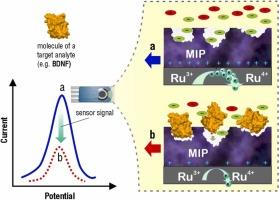氧化钌电极与分子印迹聚合物集成用于神经营养因子蛋白的直接电化学传感
IF 8
1区 化学
Q1 CHEMISTRY, ANALYTICAL
引用次数: 0
摘要
在追求精确诊断和分析方法的过程中,电化学装置已经成为一个有前途的前沿领域。本文介绍了分子印迹聚合物(MIP)层和二氧化钌(RuO2)电极之间的协同作用,作为直接检测疾病生物标志物的电化学传感器的组成部分。为此,脑源性神经营养因子(BDNF),一种潜在的神经退行性疾病的生物标志物,被选择作为目标分析物。通过将BDNF选择性MIP (BDNF-MIP)层锚定在RuO2电极上,作为衬底换能器和氧化还原活性内部探针,实现了BDNF的直接电化学分析。优化模板洗脱、再结合时间和BDNF- mip层厚度后,线性扫描伏安法(LSV)分析显示,BDNF传感器的检出限低,在缓冲液中为0.1 ng/mL,在血清中的两个线性分析范围(0 - 15 ng/mL和15 - 40 ng/mL)内有效。此外,与其他神经营养因子和其他蛋白质相比,该靶标具有特殊的歧视性选择性。重要的是,BDNF传感器在至少8次再结合再生循环中具有出色的可重用性。因此,由此产生的传感平台提供了快速和精确的生物样品分析,为加强各种科学学科的诊断和分析方法铺平了道路。本文章由计算机程序翻译,如有差异,请以英文原文为准。

Ruthenium oxide electrode integrated with molecularly imprinted polymer for direct electrochemical sensing of a neurotrophic factor protein
In the pursuit of precision diagnostics and analytical methodologies, electrochemical devices have emerged as a promising frontier. This article presents the synergy between a molecularly imprinted polymer (MIP) layer and the ruthenium dioxide (RuO2) electrode as components of an electrochemical sensor designed for direct detection of disease biomarkers. For this purpose, brain-derived neurotrophic factor (BDNF), a potential biomarker for neurodegenerative disorder, was selected as the target analyte. By anchoring a BDNF-selective MIP (BDNF-MIP) layer to RuO2 electrode functioning as both a substrate transducer and a redox-active internal probe, a direct electrochemical analysis of BDNF was achieved. Following the optimization of the template elution, rebinding time, and BDNF-MIP layer thickness, linear sweep voltammetry (LSV) analysis of the BDNF sensor demonstrated low detection limit, 0.1 ng/mL in buffer and an effective functionality within two linear analytical ranges (0–15 ng/mL and 15–40 ng/mL) in serum. Additionally, exceptional discriminatory selectivity for the target was confirmed in comparison with other neurotrophic factors, as well as other proteins. Importantly, an outstanding reusability of the BDNF sensor during at least 8 rebinding-regeneration cycles was achieved. Thus, the resulting sensing platform offers rapid and precise analysis of biological samples, paving the way for enhanced diagnostics and analytical methodologies across various scientific disciplines.
求助全文
通过发布文献求助,成功后即可免费获取论文全文。
去求助
来源期刊

Sensors and Actuators B: Chemical
工程技术-电化学
CiteScore
14.60
自引率
11.90%
发文量
1776
审稿时长
3.2 months
期刊介绍:
Sensors & Actuators, B: Chemical is an international journal focused on the research and development of chemical transducers. It covers chemical sensors and biosensors, chemical actuators, and analytical microsystems. The journal is interdisciplinary, aiming to publish original works showcasing substantial advancements beyond the current state of the art in these fields, with practical applicability to solving meaningful analytical problems. Review articles are accepted by invitation from an Editor of the journal.
 求助内容:
求助内容: 应助结果提醒方式:
应助结果提醒方式:


